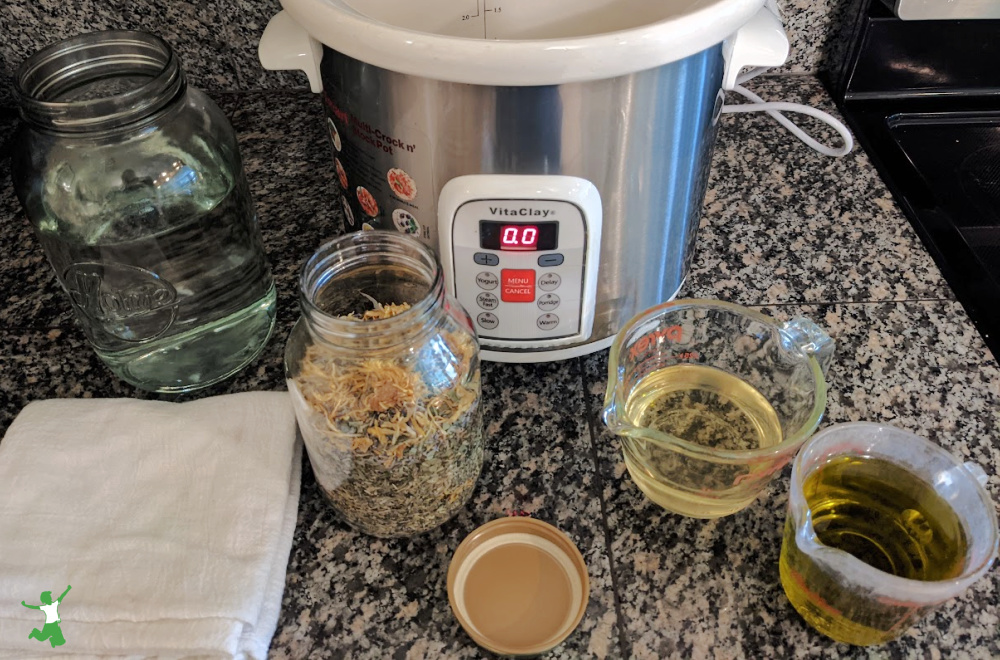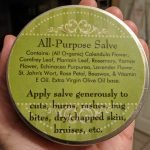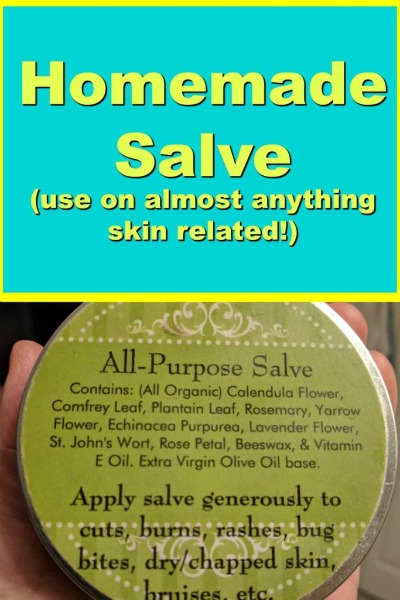All purpose herbal salve recipe with nine different therapeutic herbs including comfrey for rapid tissue healing and inflammation reduction. Great for burns, bruises, rashes, insect bites and moisturizing.

When it comes to salve, I much prefer one that will work for nearly all situations and challenges the skin may encounter. This simplifies things considerably! Everyone knows exactly what to grab and use when a skin problem crops up. It also keeps your medicine cabinet free of unnecessary tubes and jars that are confusing to sort through.
A couple of years ago, I tried a comfrey salve that functions in this manner. I originally purchased it from a local herbalist-in-training and over time, have found it to be the most effective salve I have ever tried.
My family and I have discovered that this comfrey salve works so well that we basically don’t use anything else when we have a skin problem, whether sunburn, bruise, insect bite, windburn, mild rash, or a kitchen scalding. In fact, anytime I bump or burn myself, I get this salve on the area as fast as possible as more often than not, it will prevent any sort of bruise or burn from forming.
Once I scalded about one-third of my hand as I was straining bone broth from the stockpot. I thought for sure my hand would be burned for weeks and possibly even scarred. I can’t even begin to describe how much it hurt.
Fortunately, I put a generous amount of this comfrey salve on it fast and kept reapplying until the pain subsided (which took a while). Would you believe, the skin never turned that beet red/purple color that usually indicates a bad burn. What’s more, the skin never even peeled.
Unfortunately, my herbalist friend is no longer making her homemade creations, so I’ve had to learn to make this comfrey salve myself. Fortunately, she generously shared her recipe with me so I can make and continue to use it. This turned out to be a good thing, as it is super easy to do even if you have little to no experience using herbs medicinally.
Why Comfrey for a Salve?
Used for millennia to help heal burns, sprains, bruises, and even slight bone fractures, comfrey contains allantoin which is thought to speed up the production of new cells. It’s also known as knitbone. Even its Latin name, symphytum, is derived from the Greek, “symphis”, meaning growing together of bones, and “phyton,” meaning plant.
Other Important Herbs
The healing power of comfrey to the skin and connective tissues is enhanced by five other herbs contained in this salve recipe.
- Echinacea both in its root (more potent) and leaf form is included to provide natural antibiotic properties.
- Yarrow flower also helps counter infection, stop the pain and encourage rapid healing, particularly with sunburn and kitchen burns.
- Rosemary leaf brew is an effective wash for the skin and wounds of all kinds. It also acts as a natural preservative for the salve.
- Plantain leaf, when included in an ointment, helps to counter stings, stop itches, heal wounds, and relieve pain.
- Calendula flower is included because it is useful on all external skin problems and injuries but especially those that are red, tender, and oozing. This helpful herb will also help to heal burns, bruises, and sprains. Calendula decreases swelling, clears infection, speeds tissue regeneration, and prevents scarring.
Making Your Own Salve is Easy!
While you are welcome to include any other herbs you feel would be helpful in an all-purpose salve, the ones listed above are the ones I have found to be super effective. As I mentioned before, this comfrey salve is the only one we currently use in our house for anything skin related.
It also works as a mild herbal antifungal as well.
The recipe below makes about 2 cups of herbal salve. You only need to make a batch every few years. It lasts a long time! It also makes great gifts if you divide it up into small jars to give away to friends and family.
Prefer to Buy?
There isn’t anything commercial on the market that can compare to homemade. However, if you just don’t have the time to make your own comfrey salve, you can buy a couple of similar ointments on the market.
My Mother-in-Law swears by Christopher’s Complete Tissue & Bone ointment which contains a generous amount of organic comfrey. In addition, this brand of comfrey creme will produce good results.
Another excellent remedy for bug bites and bruises that costs pennies is old-fashioned Witch Hazel.

Herbal Salve Recipe with Comfrey
All purpose medicinal herbal salve containing 9 helpful herbs including comfrey for all types of skin problems including rash, kitchen burns, sunburn, bruises, insect bites, dry/chapped skin etc.
Ingredients
- 3 oz Comfrey leaf
- 3 oz Plaintain leaf
- 3 oz Calendula flower
- 3 oz White Yarrow flower
- 3 oz Rosemary leaf
- 3 oz Echinacea purpurea root
- 3 oz Echinacea purpurea leaf
- 3 oz St. John’s Wort
- 3 oz Lavender flower
- 2+ cups Extra virgin olive oil or virgin coconut oil
- 6 oz beeswax
Instructions
-
Fill non-BPA lid mason jar two-thirds full of the herb mix above in roughly similar amounts. This is about 3 ounces by volume for each herb.
-
Gently liquefy the oil if necessary (coconut oil liquefies at 76 °F/24 °C).
-
Add the oil until it fills the mason jar. Leave one inch at the top. Screw on the lid tightly.
-
Keep on low heat (be very careful not to boil the oil as it needs to be hot to infuse the herbs, but never boiling) for 72 hours. As water evaporates, add more water to maintain the proper level.
-
After 3 days, the oil will be darkened and ready to use. Strain out the herbs using a cheesecloth or an old white cotton shirt. The comfrey infused oil may now be used as is for a wonderful massage oil.
-
To transform the oil into a salve, you need to add beeswax (get it here). Depending how much oil you have once the herbs are strained out, add 3 ounces/85 grams of grated beeswax (or beeswax pastilles) for every cup of oil. Warm the mixture together in a medium sized pot on low heat until the wax is melted. Stir gently to distribute the wax evenly. Add a drop of Vitamin E oil or wheat germ oil per 1 ounce/28 grams of oil if you desire additional natural preservative effect beyond what the rosemary provides.
-
While the salve is still warm, pour into containers of choice. Salve tins work especially well.
-
Let the containers sit until the oil hardens. Screw on the lids and be sure to label and date each one.
Recipe Video

More Information
How to Prepare an Herbal Infusion
Traditional Remedies for Modern Families
How to Make a Vinegar Compress for Bruises and Sprains
Bruise Easily? Here’s the Nutrient You Need
Wise Woman Herbal by Susun Weed








So…I’ve been using this recipe for a few years now, and it’s hugely popular with everyone I share it with.
I’ve actually made this herb mix into two forms.
One is the balm (which I hate doing, because working with oil and beeswax sucks) and the other one is an alcohol spray, which is SO much better most times!
I have previously used vodka (adapted from another recipe I found) but that gets really expensive really quickly.
AND, the dried herbs absorb a lot, so you often have to end up getting TWO bottles of vodka, which is why it gets expensive.
SO……this time, I tried something different.
Since the spray is intended for ONLY topical application, I tried isopropyl alcohol.
You can get it in big 5L bottles for about $40 – $50, and it’s SO much better!
I find that not only it dries faster on the skin, but being a pure variety of alcohol, it absorbs into the skin a bit better, delivering the herbs to where they are needed faster, which leads to a better result.
As a bonus, it turns the liquid a bright green, instead of the dark tea brown it was with the vodka.
Looks snazzy, lol!
I love this stuff!
It’s VERY good for easing or eliminating pain, immediately soothing inflammation, and of course, stopping infection.
VERY good for minor burns, and takes the pain away immediately! You have to re-apply it a few times that day, but the next day, it’s healed!
We use this spray a LOT in our house!
I am eternally grateful for people like you that share your discoveries with others.
I, in turn, always strive to do the same, and I direct anyone who’s interested to learn more, to your website. 🙂
Did you heat the alcohol and herbs to infuse it or just let it sit for multiple weeks?
I could be wrong but it seems these tins are aluminum and some are made in China. I think it would be best to use a glass jar. Great recipe though, thanks. I would personally (halve or) third the recipe and use 1 ounce of herb by volume (1/8 cup) to try it out.
Yes, glass would be best, but it is dangerous in the bathroom. I’ve seen a few get dropped a few over the years, and it is scary. Aluminum is actually not even a problem for this particular use as long as you don’t scratch it on the inside with metal. Since the salve is removed with the fingers, this is not a risk.
You can also use plastic amber jars if you prefer. Again, glass is certainly ideal, but it is just too scary particularly for children who are closer to the floor and flying pieces of glass when they drop (the salve is usually applied in the bathroom in my experience over the years).
Do you put a lid on the jar when in the crockpot?? I don’t want water / steam to enter and spoil the batch while immersed in the crockpot.
The water line is 1” below the jar top
Yes that is fine.
Hi Sarah, I do not have echinacea leaf or root but I do have Jamieson echinacea 1200 organic capsules. Can i use them in the salve. Also can i put the bottle with the oil in a sunny window to work instead of heating it? Thanks so much for this recipe. I got most of the ingredients accumulated now and will soon be ready to make the salve, Lin
I cannot find echinacea root or leaf powder. Can I use the powder from my organic Jamieson capsules 1200 mg per capsule. I can order the comfrey leaf from richters. Thanks Linda
Sorry this is hugely late, but I thought I’d answer this in case anyone else has the same question.
No, do not use the contents from capsules. You’d need ever so much, it’d be insane, and such a great waste of both money and capsules!
I also do not believe that you have looked hard enough for the echinacea root. I just did a quick Google search and lots of places sell it, including Amazon. I’m assuming that you’re in America, so for you, I’d have a look at Mountain Rose herbs? I see a lot of people from the US go on about how good they are., so have a look there.
My sources will be different, since I’m in Australia, but for some of the herbs, I had to hit up Etsy for them, and they came from the US.
I do suggest looking harder. I managed to source almost all of mine!
What do you think of using tallow instead of the oil?
Your presentation of the recipe needs to clarify the mix of herbs. I tested to assess the actual volume 3 oz each of the 9 recommended herbs. You end up with a whopping seven quarts of dry material. It took 92 oz of oil just to wet the dry material. 92 oz of oil is about 2 !/3 quarts of olive oil. Woah momma!!! Since due to the widely different densities of dry herbs, going by volume of the ingredients would give widely different quantities when looking at the weights of those herbs. In your statement about the herbs you seemed to attach some importance to the equal amounts, but is it more important by weight or by volume. For the average person without a sensitive weight scale in their kitchen a voulume measurement would be the easiest. 3 grams of each dry herb may be what you want for the size of the recipe that you have in mind. There are different size mason jars. So what size do you mean? I am assuming that you mean the size that most people use for drinking glasses that is a pint container. The two cups of oil are a pint so you must mean a 1 quart mason jar. The way you have stated the recipe can lead to widely different results. If the herbs are to be measured by volume then let’s state what the volume is supposed to be. Because of the widely different densities of the herbs especially when considering in regard to powdered or not will give far different percentages by weight if the measures are by volume. If the percentages of herbs by weight are not important then the recipe should go by volume of each herb. If that is the case let’s specify the correct measure of dry material to use that is meant to be proper for a one quart mason jar. I will help you do so if you want. This recipe is a great combination of herbs. I have looked at a number of different comfrey based recipes and this one is the best. There are a few other herbs that I found in my investigation that I think would be outstanding enough to recommend as enhancements to your recommended outstanding combination of herbs. Looking forward to hearing back from you!
3 oz by volume, not weight 🙂 Sorry, I thought that was clear when I wrote the recipe as it all fits in a mason jar!
Hello Sarah. There are different size mason jars. When using drying weights there is no such thing as 3 oz by volume when using different densities of materials. if you mean that the there should be equal volumes of the 9 different herbs then the recipe should state that this is what you mean. That being the case then saying how many tablespoons or parts of a cup of each herb should be added to the mason jar to result in the suggested ratios would be proper. Another person states that a link you provided shows that you are using a half gallon mason jar. Why not just edit the recipe and tell people if you are using a half gallon mason jar and what measure of dry volume in tablespoons or cups or parts of a cup that you are using for each of the 9 herbs?
Mmmm, it seems to me that I indicated the size mason jar? Again, I really thought it was quite obvious that it was by volume as by weight would be so much as you pointed out.
Thank you for that. The recipe was odd. Curious what your additions would be?
My family loves this salve! Will be making this again.
I have some comfrey roots and want to make the salve. However, the roots have a dark almost black skin and I don’t know if I need to peel that off or just leave it on.
Please let me know what you do.
I was confused as well until I read that it was by volume and not by weight. Huge difference! 🙂
Hi Mike, Sarah’s link shows that the canning jar is a 64oz/ 1/2 gallon / 1.9 L size. So that’s why your herbs aren’t fitting into the quart-size jar you’re using. Also, did you weigh out 3 oz. of each herb before adding to your jar? Sarah’s recipe clearly states that the 3oz. is a volume measurement and not measured by weight. That’s another reason you could have had a problem.